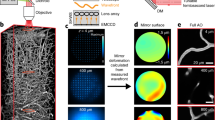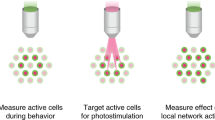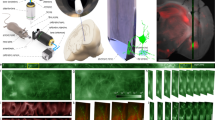Abstract
We present a method to form an optical window in the mouse skull that spans millimeters and is stable for months without causing brain inflammation. This enabled us to repeatedly image blood flow in cortical capillaries of awake mice and determine long-range correlations in speed. We also repeatedly imaged dendritic spines, microglia and angioarchitecture, as well as used illumination to drive motor output via optogenetics and induce microstrokes via photosensitizers.
This is a preview of subscription content, access via your institution
Access options
Subscribe to this journal
Receive 12 print issues and online access
$259.00 per year
only $21.58 per issue
Buy this article
- Purchase on Springer Link
- Instant access to full article PDF
Prices may be subject to local taxes which are calculated during checkout



Similar content being viewed by others
References
Svoboda, K., Denk, W., Kleinfeld, D. & Tank, D.W. Nature 385, 161–165 (1997).
Levasseur, J.E., Wei, E.P., Raper, A.J., Kontos, A.A. & Patterson, J.L. Stroke 6, 308–317 (1975).
Grutzendler, J., Kasthuri, N. & Gan, W.B. Nature 420, 812–816 (2002).
Trachtenberg, J.T. et al. Nature 420, 788–794 (2002).
Brown, C.E., Li, P., Boyd, J.D., Delaney, K.R. & Murphy, T.H. J. Neurosci. 27, 4101–4109 (2007).
Xu, H.T., Pan, F., Yang, G. & Gan, W.B. Nat. Neurosci. 10, 549–551 (2007).
Hauss-Wegrzyniak, B., Lynch, M.A., Vraniak, P.D. & Wenk, G.L. Exp. Neurol. 176, 336–341 (2002).
Sohler, T.P., Lothrop, G.N. & Forbes, H.S. J. Pharmacol. Exp. Ther. 71, 331–335 (1941).
Holtmaat, A. et al. Nat. Protoc. 4, 1128–1144 (2009).
Kleinfeld, D., Mitra, P.P., Helmchen, F. & Denk, W. Proc. Natl. Acad. Sci. USA 95, 15741–15746 (1998).
Stoll, G. & Jander, S. Prog. Neurobiol. 58, 233–247 (1999).
Pekny, M. & Nilsson, M. Glia 50, 427–434 (2005).
Fox, M.D. & Raichle, M.E. Nat. Rev. Neurosci. 8, 700–711 (2007).
Blinder, P., Shih, A.Y., Rafie, C.A. & Kleinfeld, D. Proc. Natl. Acad. Sci. USA 107, 12670–12675 (2010).
Sawinski, J. et al. Proc. Natl. Acad. Sci. USA 106, 19557–19562 (2009).
Jung, S. et al. Mol. Cell. Biol. 20, 4106–4114 (2010).
Arenkiel, B.R. et al. Neuron 54, 205–218 (2007).
Masino, S.A., Kwon, M.C., Dory, Y. & Frostig, R.D. Proc. Natl. Acad. Sci. USA 90, 9998–10002 (1993).
Stosiek, C., Garaschuk, O., Holthoff, K. & Konnerth, A. Proc. Natl. Acad. Sci. USA 100, 7319–7324 (2003).
Kleinfeld, D. & Delaney, K.R. J. Comp. Neurol. 375, 89–108 (1996).
Denk, W. et al. J. Neurosci. Methods 54, 151–162 (1994).
Tsai, P.S. & Kleinfeld, D. in Methods for In Vivo Optical Imaging 2nd edn. (ed., R.D. Frostig) 59–115 (CRC Press, 2009).
Tsai, P.S. et al. Neuron 39, 27–41 (2003).
Nguyen, Q.-T., Dolnick, E.M., Driscoll, J. & Kleinfeld, D. in Methods for In Vivo Optical Imaging 2nd edn. (ed., R.D. Frostig) 117–142 (CRC Press, Boca Raton, 2009).
Nguyen, Q.-T., Tsai, P.S. & Kleinfeld, D. J. Neurosci. Methods 156, 351–359 (2006).
Shih, A.Y. et al. J. Cereb. Blood Flow Metab. 29, 738–751 (2009).
Shih, A.Y. et al. in Imaging in Neuroscience and Development (ed., R. Yuste) volume 2, chapter 15 (Cold Spring Harbor Laboratory Press, in the press).
Valmianski, I. et al. J. Neurophysiol. 104, 1803–1811 (2010).
Drew, P.J., Blinder, P., Cauwenberghs, G., Shih, A.Y. & Kleinfeld, D. J. Comput. Neurosci. 29, 5–11 (2010).
McMenamin, P.G. J. Comp. Neurol. 405, 553–562 (1999).
Ferezou, I. et al. Neuron 56, 907–923 (2007).
Knutsen, P.M., Derdikman, D. & Ahissar, E. J. Neurophysiol. 93, 2294–2301 (2005).
Nishimura, N., Schaffer, C.B., Friedman, B., Lyden, P.D. & Kleinfeld, D. Proc. Natl. Acad. Sci. USA 104, 365–370 (2007).
Born, M. & Wolf, E. Principles of Optics: Electromagnetic Theory of Propagation Interference and Diffraction of Light 6th edn. (Pergamon Press, Oxford, 1980).
Acknowledgements
We thank B. Friedman, C. Portera-Cailliau and K. Svoboda for critical comments on an early version of the manuscript, M. Fuentes and C. Petersen for advice on head fixation, D.N. Hill for discussions on data analysis, J. Lee and K. Yang for help with animal husbandry, J.D. Moore for discussions on optical stimulation, and S. Tayman for a gift of tin oxide. This work was supported by grants from the US National Institutes of Health (EB003832, MH085499, NS059832 and RR021907 to D.K., and NS066361 to K.A.) and the Dana Program in Brain and Immuno-imaging (to K.A.) and fellowships from the Israeli Science Foundation (to P.B.), the Canadian Institutes of Health Research and American Heart Association (to A.Y.S.), the Human Frontiers Scientific Program (to P.M.K.), and the US National Multiple Sclerosis Society (to D.D.).
Author information
Authors and Affiliations
Contributions
P.J.D., A.Y.S. and P.S.T. conceived the PoRTS window; J.D.D. and D.K. developed the imaging tools; K.A., D.D., P.J.D., D.K., A.Y.S. and P.S.T. designed the experiments; P.J.D., P.M.K., A.Y.S. and P.S.T. carried out the experiments; P.B., P.J.D., D.K. and P.S.T. analyzed data; and P.J.D., D.K. and A.Y.S. wrote the manuscript.
Corresponding author
Ethics declarations
Competing interests
The authors declare no competing financial interests.
Supplementary information
Supplementary Text and Figures
Supplementary Figures 1-10, Supplementary Note 1 (PDF 1711 kb)
Rights and permissions
About this article
Cite this article
Drew, P., Shih, A., Driscoll, J. et al. Chronic optical access through a polished and reinforced thinned skull. Nat Methods 7, 981–984 (2010). https://doi.org/10.1038/nmeth.1530
Received:
Accepted:
Published:
Issue Date:
DOI: https://doi.org/10.1038/nmeth.1530
This article is cited by
-
Computational conjugate adaptive optics microscopy for longitudinal through-skull imaging of cortical myelin
Nature Communications (2023)
-
Synchronized activity of sensory neurons initiates cortical synchrony in a model of neuropathic pain
Nature Communications (2023)
-
Intravital Imaging Reveals the Ameliorating Effect of Colchicine in a Photothrombotic Stroke Model via Inhibition of Neutrophil Recruitment
Translational Stroke Research (2023)
-
A Through-Intact-Skull (TIS) chronic window technique for cortical structure and function observation in mice
eLight (2022)
-
Arterial vasodilation drives convective fluid flow in the brain: a poroelastic model
Fluids and Barriers of the CNS (2022)



